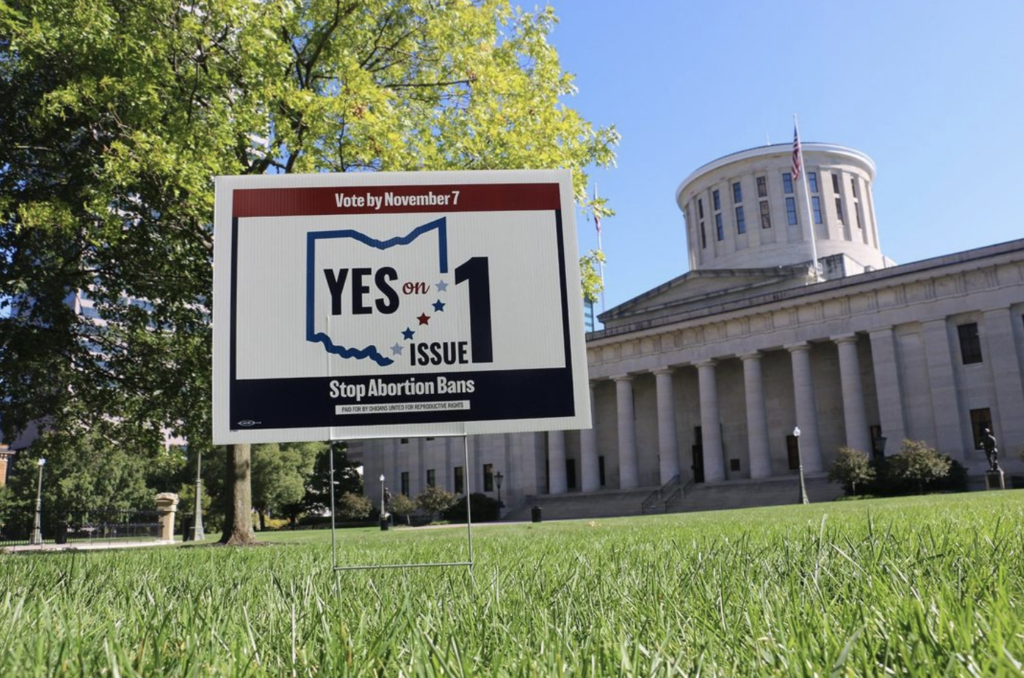Updated Friday, Oct. 27, at 1:45 a.m. PT.

This November, Ohioans will decide whether to add to the state’s constitution the right for individuals to make their own reproductive healthcare decisions, including abortion. Early voting in the election has already begun.
Ohio Issue 1—the Right to Make Reproductive Decisions Including Abortion Initiative—would add this language to the Ohio state constitution: “Every individual has a right to make and carry out one’s own reproductive decisions, including but not limited to decisions on: contraception, fertility treatment, continuing one’s own pregnancy, miscarriage care, and abortion.” The amendment would preclude the state from interfering, burdening or prohibiting the exercise of such a right—directly or indirectly.
A coalition of reproductive, women’s and civil rights organizations, Ohioans United for Reproductive Rights, is urging voters to vote YES on Issue 1 to protect reproductive freedom. If passed, the amendment would restore Roe-era protections in Ohio and prevent a six-week abortion ban (that has no exceptions for rape or incest and which is the subject of ongoing litigation) from ever taking effect.
Early voters in Democratic-leaning counties have begun showing up in droves—already exceeding the significant turnout from August’s special election. Both urban and suburban Democratic counties are seeing significant increases in votes. “For these things that are on the ballot right now, which are very important, I just wanted to make sure my vote is in and counted,” one voter told News 5 Cleveland. Early voting continues till Nov. 5.
Notably, the ballot language looks different from the actual amendment: The state’s Republican-led ballot board drafted the language for the ballot, which does not specify which reproductive-health-related decisions would be protected by the amendment and refers to a “fetus” as an “unborn child,” among other departures from the original language of the proposed amendment. (Read the entire ballot initiative at the end of this article, as well as the text of the proposed amendment.)
The Republican-led effort is part of a larger campaign to confuse voters, and follows an unsuccessful attempt earlier this year by the Republican legislature to change the election rules to increase the votes required to pass a measure on the ballot from a simple majority to 60 percent. Voters rejected the proposed rules change in a special election in August.
Ohioans, here’s all you need to know about how to vote in this election.
How to Vote
First, check whether you are registered to vote in Ohio. (You can check here.)
When can I vote early?
You can vote in person early on any of the following dates within the specified time periods:
- Oct. 16-20: 8:00 a.m.-5:00 p.m.
- Oct. 23-27: 8:00 a.m.-5:00 p.m.
- Oct. 30: 7:30 a.m.-7:30 p.m.
- Oct. 31: 7:30 a.m.-8:30 p.m.
- Nov. 1-3: 7:30 a.m.-7:30 p.m.
- Nov. 4: 8:00 a.m.-4:00 p.m.
- Nov. 5: 1:00 p.m.-5:00 p.m.
Early voting locations are listed here.
Where can I vote on Election Day, Nov. 7?
You can find your polling place here (a link where you can also find your registration status) or here (click on your county/county name to search your address).
What ID is required to vote in person?
A photo ID is required for in-person voting; acceptable means of identification include: an Ohio driver’s license, an Ohio ID card, a U.S. passport or passport card, a U.S. military ID, a U.S. Department of Veterans Affairs ID, or an Ohio National Guard ID.
Out-of-state driver’s licenses are not valid IDs. Student IDs are also not accepted as means of identification.
If you do not bring an acceptable form of ID, or if your eligibility is in question when you go to vote, you can still vote using a provisional ballot.
How can I vote absentee?
In Ohio, anyone can vote absentee; no excuse is required.
If you plan on voting absentee, complete the state’s relevant absentee ballot request form, print it, sign it and mail it to your county board of elections.
Alternatively, you may call your board of elections, request that they mail you an absentee ballot application, and send it back to them once it is completed.
You can find the address of your county board of elections here.
The deadline to request an absentee ballot is Oct. 31 by 8:30 p.m. local time.
After your election board receives your absentee ballot application, you can track your absentee ballot while it makes its way to you. Once it arrives and you complete it, you must postmark it no later than Nov 6. You can also return your absentee ballot in person; if you do, it must get to the board of elections before 7:30 p.m. on Election Day, Nov. 7.
Can I participate in election advocacy on Issue 1?
Sign up for canvassing and phone banking events with Ohioans United for Reproductive Rights here.
What is the exact text of the proposed amendment?
The full text of the proposed amendment is as follows:
Be it Resolved by the People of the State of Ohio that Article I of the Ohio Constitution is amended to add the following Section:
Article I, Section 22. The Right to Reproductive Freedom with Protections for Health and Safety
A. Every individual has a right to make and carry out one’s own reproductive decisions, including but not limited to decisions on:
- contraception;
- fertility treatment;
- continuing one’s own pregnancy;
- miscarriage care; and
- abortion
B. The State shall not, directly or indirectly, burden, penalize, prohibit, interfere with, or discriminate against either:
- An individual’s voluntary exercise of this right or
- A person or entity that assists an individual exercising this right
unless the State demonstrates that it is using the least restrictive means to advance the individual’s health in accordance with widely accepted and evidence-based standards of care.
However, abortion may be prohibited after fetal viability. But in no case may such an abortion be prohibited if in the professional judgment of the pregnant patient’s treating physician it is necessary to protect the pregnant patient’s life or health.
C. As used in this Section:
- “Fetal viability” means “the point in a pregnancy when, in the professional judgment of the pregnant patient’s treating physician, the fetus has a significant likelihood of survival outside the uterus with reasonable measures. This is determined on a case-by-case basis.”
- “State” includes any governmental entity and any political subdivision.
D. This Section is self-executing.
What exactly will my ballot ask of me?
View a sample ballot here.
The exact text of Ohio Issue 1 reads:
Issue 1
A Self-Executing Amendment Relating to Abortion and Other Reproductive DecisionsProposed Constitutional Amendment
Proposed by Initiative Petition
To enact Section 22 of Article I of the Constitution of the State of Ohio
A majority yes vote is necessary for the amendment to pass.
The proposed amendment would:
- Establish in the Constitution of the State of Ohio an individual right to one’s own reproductive medical treatment, including but not limited to abortion;
- Create legal protections for any person or entity that assists a person with receiving reproductive medical treatment, including but not limited to abortion;
- Prohibit the State from directly or indirectly burdening, penalizing, or prohibiting abortion before an unborn child is determined to be viable, unless the State demonstrates that it is using the least restrictive means;
- Grant a pregnant woman’s treating physician the authority to determine, on a case-by-case basis, whether an unborn child is viable;
- Only allow the State to prohibit an abortion after an unborn child is determined by a pregnant woman’s treating physician to be viable and only if the physician does not consider the abortion necessary to protect the pregnant woman’s life or health; and
- Always allow an unborn child to be aborted at any stage of pregnancy, regardless of viability if, in the treating physician’s determination, the abortion is necessary to protect the pregnant woman’s life or health.
If passed, the amendment will become effective 30 days after the election.
Shall the amendment be approved?
Voters will also be asked about Ohio Issue 2, the Marijuana Legalization Initiative. A “yes” vote supports legalizing marijuana use for adults 21 and older, allowing adults to possess up to 2 and ½ ounces of marijuana in any form except adult-use extract, which cannot exceed 15 grams. Adults 21 and older would also be permitted to grow up to six cannabis plants.
Up next:
U.S. democracy is at a dangerous inflection point—from the demise of abortion rights, to a lack of pay equity and parental leave, to skyrocketing maternal mortality, and attacks on trans health. Left unchecked, these crises will lead to wider gaps in political participation and representation. For 50 years, Ms. has been forging feminist journalism—reporting, rebelling and truth-telling from the front-lines, championing the Equal Rights Amendment, and centering the stories of those most impacted. With all that’s at stake for equality, we are redoubling our commitment for the next 50 years. In turn, we need your help, Support Ms. today with a donation—any amount that is meaningful to you. For as little as $5 each month, you’ll receive the print magazine along with our e-newsletters, action alerts, and invitations to Ms. Studios events and podcasts. We are grateful for your loyalty and ferocity.





